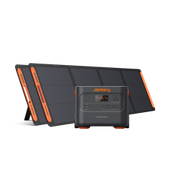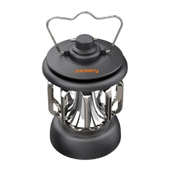How Does a Lithium-ion Battery Work?
Lithium-ion batteries are becoming increasingly popular these days. You can find them in common electrical appliances like laptops and even in portable power stations. These battery backups are safe rechargeable charging solutions that are generally lighter than other types. They come in different shapes and sizes, and that's why you need to understand "how does a lithium-ion battery work" before choosing a battery backup for homes.
 If you're looking for portable power stations with highly efficient and powerful LiFePO4 or NMC batteries, Jackery has got your back. The Jackery Solar Generators consist of Jackery Explorer Portable Power Stations and Jackery SolarSaga Solar Panels to keep all your appliances charged for long hours. The following table reveals the technical specifications of the popular Jackery power stations.
If you're looking for portable power stations with highly efficient and powerful LiFePO4 or NMC batteries, Jackery has got your back. The Jackery Solar Generators consist of Jackery Explorer Portable Power Stations and Jackery SolarSaga Solar Panels to keep all your appliances charged for long hours. The following table reveals the technical specifications of the popular Jackery power stations.
|
Products |
Image |
Capacity |
Rated / Peak Power |
Battery |
Size |
|
 |
3024Wh |
3000W (6000W Peak) |
NMC |
Length: 18.6 in (47.24 cm) Width: 14.1 in (35.81 cm) Height: 14.7 in (37.36 cm) |
|
|
 |
2160Wh |
2200W (4400W Peak) |
NMC |
Length: 15.1 in (38.4 cm) Width: 10.5 in (26.9 cm) Height: 12.1 in (30.75 cm) |
|
|
 |
2-24 kWh |
3000W (6000W Peak) |
LiFePO4 |
Length: 14.7 in (37.36 cm) Width: 18.6 in (47.3 cm) Height: 14.1 in (35.94 cm) |
|
|
|
1512Wh |
1800W (3600W Peak) |
NMC |
Length: 15.12 in Width: 10.59 in Height: 12.11 in |
What is a Lithium-ion Battery?
Lithium-ion batteries have single or multiple lithium-ion cells and a protective circuit board. Once the Li cell or cells are installed inside a device along with a protective circuit board, they are referred to as batteries. Each cell has three main parts: a liquid electrolyte, a positive electrode (a cathode), and a negative electrode (an anode). Here is a brief explanation of the composition of a lithium-ion battery.
- Electrodes: The ends of the positively and negatively charged cells attached to the current collectors represent electrodes.
- Electrolyte: It's a liquid or gel that conducts electricity and is generally placed between an anode and a cathode.
- Current Collector: Each electrode of the battery has conductive foils that are further connected to the cell terminals. The role of these terminals is to transmit the electric current between the device, battery, and energy source that powers the battery.
- Separator: It's a porous polymeric film that separates the electrodes while streamlining the exchange of lithium ions from one side to another.
 Here are the advantages and disadvantages of lithium-ion batteries.
Here are the advantages and disadvantages of lithium-ion batteries.Advantages
- Lithium-ion batteries have a long lifespan and extended shelf life.
- They have low self-discharge, which is less than half of NiMH and NiCD.
- These batteries have reasonably shorter charge times and simple charge algorithms.
- They are known for low internal resistance and high capacity.
Disadvantages
- Lithium-ion batteries may degrade at very high temperatures or when stored at high voltage.
- They require a protection circuit to prevent thermal runaway.
Types of Lithium-ion Batteries
Typically, there are six different types of lithium-ion batteries with different chemical compositions.
- Lithium Nickel Manganese Cobalt Oxide (NMC):They typically have a large proportion of nickel, which increases the energy density of the battery and even allows for longer ranges in EVs.
- Lithium Nickel Cobalt Aluminum Oxide (NCA): They come with high energy density and increased stability. However, they are less safe than lithium-ion batteries and are highly expensive.
- Lithium Iron Phosphate:They are cheaper than nickel-based variants, offer less specific energy, and have a long lifespan.
- Lithium Cobalt Oxide: These batteries are highly energy-dense and popular for low-load applications, such as laptops and smartphones.
- Lithium Manganese Oxide: LMO offers enhanced safety and fast charging and discharging capabilities.
- Lithium Titanate: LTO batteries have a unique anode surface built with lithium and titanium oxides. While these batteries perform well in extreme temperatures, they are relatively expensive.
How do Lithium-ion Batteries Work?
When you charge a Li battery, the lithium ions (Li+) move from a positive cathode to a negative anode. They pass through the electrolyte medium until they reach the negative electrode. On the other hand, the electrons or negative ions move from the anode to the cathode. The cycle repeats itself hundreds of times, making the lithium-ion battery rechargeable.

While discharging, the exact opposite of the above process happens. The Li ions return to the positive end or electrode, whereas the electrons move to the negative end.
Now that you know how does a lithium-ion battery work, you'll need to understand how it stores energy. The anode and cathode parts are capable of storing lithium ions. The current flows from the anode end to the cathode while storing energy (or during the charging process). Similarly, the lithium-ions move in the reverse direction (cathode to anode). The potential difference between the two electrodes indicates the battery starts charging.

During the discharging process, the lithium ions move to the cathode, indicating the energy being used.
Applications of Lithium-ion Batteries
Li-ion is the go-to battery for many portable electronic appliances. Here are a few essential applications of lithium-ion batteries.
Example 1: Personal Use
Rechargeable lithium-ion batteries have become popular for smartphones, laptops, and other portable electronic devices. They have low maintenance costs, high energy density, and lightweight nature, making them ideal for small electronic devices.
Example 2: Vehicle Use
Lithium-ion batteries have higher energy density and excellent recharge rates than other vehicle recharging methods. Golf carts and trolley makers are now choosing lithium batteries because they have a long lifespan of 1000 and 2000 charging cycles.
Jackery Explorer Portable Power Stations are lightweight, robust, and powerful charging solutions for most appliances. Whether you want to charge indoor electrical devices like refrigerators or power outdoor equipment like electric blankets, Jackery Explorer Portable Power Stations have your back.
Jackery Portable Power Stations Explained
With the growing use of electric devices, investing in a portable charging solution is essential. Jackery provides many compact, powerful, and portable power stations, solar generators, and solar panels. The Jackery SolarSaga Solar Panels comprise highly efficient monocrystalline silicon solar cells that collect and convert the direct sun's rays into DC electricity. The pure sine wave inverter then converts the DC electricity into usable AC electricity to charge home or outdoor appliances.
Jackery Explorer 3000 Pro Portable Power Station
The powerful Jackery Explorer 3000 Pro Portable Power Station features a large battery capacity of 3024Wh. Its portable design consists of pull rods and double wheels, making transportation easy. It's even an excellent choice for indoor use, all thanks to its ability to operate with less than 30dB noise emissions.

|
|
|
|
Capacity |
3024Wh |
|
Lifecycle |
2000 cycles to 70%+ capacity |
|
Battery |
NMC |
|
Dimension |
Length: 18.6 in (47.24 cm) Width: 14.1 in (35.81 cm) Height: 14.7 in (37.36 cm) |
|
Recharging Methods |
Solar Recharging: 3.5 H (6*Jackery SolarSaga 200W Solar Panels) Wall Recharging: 2.4 H Car Recharging: 35 H |
|
Output Ports |
AC Output (x1): 120V~ 60Hz 25A Max AC Output (x3): 120V~ 60Hz 20A Maximum USB-C Output (x2): 100W Maximum, 5V⎓3A, 9V⎓3A, 12V⎓3A, 15V⎓3A, 20V⎓5A |
|
Working Hours |
Portable Air Conditioner (1150W): 2.2H Electric Oven (1600W): 1.6H Refrigerator (500W): 5.1H Heater (1800W): 1.4H Microwave (700W): 3.6H Electric Drill (900W): 2.8H Kettle (850W): 3H Coffee Maker (1100W): 2.3H |
|
Review |
Used this during my last camping trip and it is awesome! Powered my microwave, portable fridge/freezer, 2 heated blankets at night and still have plenty of battery left the next day. — Chris. |
Jackery Explorer 2000 Pro Portable Power Station
The Jackery Explorer 2000 Pro Portable Power Station has a battery capacity of 2160Wh and a high power output of 2200W. The 6*Jackery SolarSaga 200W Solar Panels can charge the power station in under 2.5 hours using free sunlight. In addition, you can recharge this NMC battery using an AC adapter in 2 hours.

|
|
|
|
Capacity |
2160Wh |
|
Lifecycle |
1000 cycles to 80%+ capacity |
|
Battery |
NMC |
|
Dimension |
Length: 15.1 in (38.4 cm) Width: 10.5 in (26.9 cm) Height: 12.1 in (30.75 cm) |
|
Recharging Methods |
Solar Recharging: 5.5 H (6*Jackery SolarSaga 100W Solar Panels) Wall Recharging: 2 H Car Recharging: 24 H |
|
Output Ports |
AC Output (x3): 120V, 60Hz, 2,200W (4,400W Surge Surge) USB-A Output (x2): Quick Charge 3.0, 18W Maximum USB-C Output (x2): 100W Maximum, (5V, 9V, 12V, 15V, 20V up to 5A) |
|
Working Hours |
Portable Air Conditioner (1150W): 1.6H Electric Oven (1600W): 1.1H Refrigerator (500W): 3.6H Heater (1800W): 1H Microwave (700W): 2.6H Electric Drill (900W): 2H Kettle (850W): 2.1H Coffee Maker (1100W): 1.6H |
|
Review |
I am impressed with how easy it is to use. No gas smells, no exhaust fumes, and plenty of power. The generator runs many different devices all at once as long as you keep the output wattage within the 2200-wattage range. — Franklin. |
Jackery Explorer 2000 Plus Portable Power Station
The Jackery Explorer 2000 Plus Portable Power Station has an outstanding LiFePO4 battery with a 10-year lifespan. It has a battery capacity of 2042.8Wh and can be expanded to 24kWh with the help of Jackery Battery Pack 2000 Plus. The superior LiFePO4 battery is highly durable and can charge 99% of home appliances.

|
|
|
|
Capacity |
2-24kWh |
|
Lifecycle |
4000 cycles to 70%+ capacity |
|
Battery |
LiFePO4 |
|
Dimension |
Length: 14.7 in (37.36 cm) Width: 18.6 in (47.3 cm) Height: 14.1 in (35.94 cm) |
|
Recharging Methods |
Solar Recharging: 2 H (6*Jackery SolarSaga 200W Solar Panels) Wall Recharging: 2 H Car Recharging: 25 H |
|
Output Ports |
AC Output (×4) 120V~ 60Hz, 20A Maximum AC Output (×1) 120V~ 60Hz, 25A Maximum USB-A Output (x2): Quick Charge 3.0, 18W Maximum USB-C Output (x2): 100W Maximum, (5V, 9V, 12V, 15V, 20V up to 5A) |
|
Working Hours |
Portable Air Conditioner (1150W): 1.5H Electric Oven (1600W): 1H Refrigerator (500W): 3.4H Heater (1800W): 57 min Microwave (700W): 2.5H Electric Drill (900W): 1.9H Kettle (850W): 2H Coffee Maker (1100W): 1.6H |
|
Review |
A very good product for travel and power outages! Well built and as advertised. Works great! — Gerard Stevens. |
Jackery Explorer 1500 Pro Portable Power Station
The Jackery Explorer 1500 Pro Portable Power Station has a weight of 37.4 lbs and a battery capacity of 1512Wh. It features one car charger, two USB-C charging ports, three 1800W AC charging ports, and a dual PD100W design to charge multiple devices simultaneously. With 6*Jackery SolarSaga 200W Solar Panels, the Jackery Explorer 1500 Pro can be recharged in only 2 hours.

|
|
|
|
Capacity |
1512Wh |
|
Lifecycle |
1000 cycles to 80%+ capacity |
|
Battery |
NMC |
|
Dimension |
Length: 15.12 in (38.4 cm) Width: 10.59 in (26.9 cm) Height: 12.11 in (30.75 cm) |
|
Recharging Methods |
Solar Recharging: 4 H (6*Jackery SolarSaga 100W Solar Panels) Wall Recharging: 2 H Car Recharging: 16.5 H |
|
Output Ports |
AC Output (x3): 120V, 60Hz, 1,800W (3,600W Surge) USB-A Output (x2): Quick Charge 3.0x2, 18W Maximum USB-C Output (x2): 100W Maximum, (5V, 9V, 12V, 15V, 20V up to 5A) |
|
Working Hours |
Portable Air Conditioner (1150W): 1.1H Refrigerator (500W): 2.5H Microwave (700W): 1.8H Electric Drill (900W): 1.4H Kettle (850W): 1.5H Coffee Maker (1100W): 1.1H |
|
Review |
I needed a portable generator for use in an RV for a CPAP machine, so I decided to get the Jackery Explorer 1500 Pro because of the long usage time and fast recharge! — Doug Richards. |
How to Choose the Lithium-ion Batteries?
While choosing the best lithium-ion battery, you must consider a few key factors.
Voltage: The voltage of the Li battery should match the inverter's voltage.
Energy Density: The amount of energy safely stored in a given battery per liter. The batteries with high energy densities are generally compact and can charge applications for long hours.
Charge Rate: The rate defines the speed at which a battery can be safely charged. A power station or battery backup solution with a high charge rate can generally be recharged faster.
Operating Temperature Range: Depending on how and where you want to use the lithium-ion battery, you need to consider the operating temperature range in which a battery can be used safely. For example, if you want to charge appliances in a frigid climate, ensure the battery has an extended operating temperature range.
Service Life: Choosing a battery with many charge/discharge cycles or a specific time in which the battery provides sufficient input and output power is ideal.
Safety: Lithium-ion batteries are much safer compared to other battery types. Jackery Explorer Portable Power Stations take safety to the next level, all thanks to state-of-the-art temperature sensors and intelligent BMS technology.

Battery Ratings FAQs
How a lithium-ion battery is made?
Lithium-ion batteries are made up of a set of electrodes assembled in cells. The production process consists of three main stages: electrode manufacturing, cell assembly, and cell finishing. First, the cells are welded on both the anode and cathode sides of the plates, which are then assembled into packs.
What is the standard battery rating?
The standard battery rating or C rating measures the current in which it is charged and discharged. The battery capacity is generally rated at 1C Rate (or 1C current).
How is a lithium battery different from a regular battery?
The primary difference between lithium and regular batteries is the material used as anode, cathode, and electrolyte. A typical battery or a lead-acid battery uses lead as an anode and lead oxide as a cathode. On the contrary, the lithium-ion battery uses carbon as an anode and lithium oxide as a cathode. Since lithium is an exceptionally light metal, lithium batteries have higher energy density than any battery cell.
Why is lithium so good as a battery?
Unlike regular batteries or traditional battery technology, Li batteries last longer, have a higher power density, and charge faster. In addition, lithium batteries weigh much less than conventional batteries, making them a great choice for portable power stations, smartphones, and more.
What is the difference between a lithium-ion battery and a lithium battery?
Lithium batteries are the primary cells, whereas lithium-ion batteries are secondary cells. The term primary cells means they are not rechargeable, while the secondary cells can be recharged repeatedly. The main difference between lithium-ion and lithium batteries is that Li batteries are rechargeable while their counterparts are not.
Final Thoughts
Lithium-ion batteries have the highest charge density compared to other systems, giving a ton of energy without being very heavy. They are known for their durability, safety, rechargeability, and long-lasting power supply. Once you understand "how does a lithium-ion battery work," you can choose the right battery backup solution to charge your appliances.
Jackery Explorer Portable Power Stations are typically built with NMC and LiFePO4 battery types. You can recharge these power stations using Jackery SolarSaga Solar Panels, an AC adapter, and even a car charger. While the Jackery Explorer 1500 Pro Portable Power Station is a great lightweight choice for charging home and outdoor appliances, the Jackery Explorer 300 Pro can supply electricity to 99% of home devices.
Disclaimer:
The runtime mentioned for appliances powered by Jackery is for reference only. Actual runtime may vary under different conditions. Please refer to real-world performance for accurate results.













































































































Leave a comment